Books & Monographs
Moving within Borders: Addressing the Potentials and Risks of Mass Migrations in Developing Countries, co-authored with William Ascher (Palgrave Springer 2024). Available here.
This book highlights the attention that policymakers, activists, and the public should pay to internal migration. Although prominent research has analyzed particular types of internal migration, especially urbanization and internally displaced persons (IDPs), the narrow 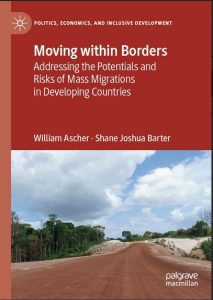 scope of existing studies cannot capture the overlaps of motivation and circumstances that pose serious policy dilemmas. The book is distinctive in examining the full range of modes and motives of internal migration: state-sponsored or unsponsored, coerced or voluntary, land-seeking or market-seeking, urban or rural, and so on. While approaching internal migration holistically, it also emphasizes how it is distinct from international migrations, especially the central role of the state, whose internal divisions and defensive reactions to challenges often play decisive roles in governing migration. The writing style is geared towards accessibility, making it appropriate for college- and graduate-level students as well as the broader public.
scope of existing studies cannot capture the overlaps of motivation and circumstances that pose serious policy dilemmas. The book is distinctive in examining the full range of modes and motives of internal migration: state-sponsored or unsponsored, coerced or voluntary, land-seeking or market-seeking, urban or rural, and so on. While approaching internal migration holistically, it also emphasizes how it is distinct from international migrations, especially the central role of the state, whose internal divisions and defensive reactions to challenges often play decisive roles in governing migration. The writing style is geared towards accessibility, making it appropriate for college- and graduate-level students as well as the broader public.
Fighting Armed Conflicts in Southeast Asia: Ethnicity and Difference (Cambridge University Press, Elements Series on Politics and Society in Southeast Asia, 2020). Available on Amazon here.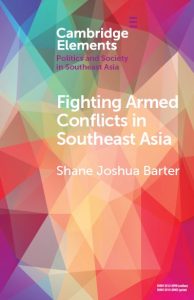
This Element seeks to make sense of Southeast Asia’s numerous armed conflicts. It makes four contributions. First, this study provides a typology, distinguishing between revolutionary, secessionist, and communal conflicts. The first two are types of insurgencies, while the latter are ethnic conflicts. Second, this study emphasizes the importance of ethnicity in shaping conflict dynamics. This is true even for revolutionary conflicts, which at first glance may appear unrelated to ethnicity. A third contribution relates to broad conflict trends. Revolutionary and secessionist conflicts feature broad historical arcs, with clear peaks and declines, while communal conflicts occur more sporadically. The fourth contribution ties these points together by focusing on conflict management. Just as ethnicity shapes conflicts, ethnic leaders and traditions can also promote peace. Cultural mechanisms are especially important for managing communal conflicts, the lone type not declining in Southeast Asia.
Internal Migration: Challenges in Governance and Integration, co-edited with William Ascher (Peter Lang, 2019). Available on Amazon here.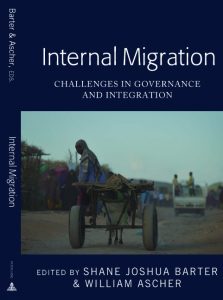
Internal Migration: Challenges in Governance and Integration focuses on the challenges associated with internal migration across the developing world. While international migration captures significant attention, less attention has been paid to those migrating within recognized national borders. The sources of internal migration are not fundamentally different from international migration, as migrants may be pushed by violence, disasters, or state policies, or pulled by various opportunities. Although they do not cross international borders, they may still cross significant internal borders, with cultural differences and perceived state favoritism generating a potential for ‘sons of the soil’ conflicts. As citizens, internal migrants are in theory to be provided legal protection by host states, however this is not always the case, and sometimes their own states represent the cause of their displacement. The chapters in this volume explain how international organizations, host states, and host communities may navigate the many challenges associated with internal migration.
The Pacific Basin: An Introduction, co-edited with Michael Weiner (Routledge, 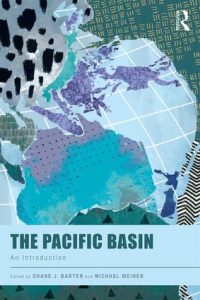 2017). Available on Amazon here.
2017). Available on Amazon here.
This textbook provides an interdisciplinary and comparative overview of the emerging Pacific world. Interest in the Pacific Basin has increased markedly in recent years, driven largely by the rise of China as a global rival to the United States and Asian development more generally. Growth in eastern Asia as well as the western Americas has led the Pacific Basin to evolve as a dynamic economic zone. The Pacific Basin: An Introduction is a key textbook for undergraduate courses on the Pacific Basin, the Pacific Rim, International Studies, Geography, World History, and Globalization.
Explaining the Genetic Footprints of Catholic and Protestant Colonizers (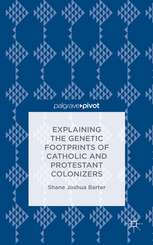 Palgrave, 2015). Available on Amazon here.
Palgrave, 2015). Available on Amazon here.
European colonizers initiated liaisons with local women and created mixed communities, but they did so at different rates and understood it in different ways. Observers have long noted the Portuguese proclivity to mix, while Spanish and French colonizers literally spawned mestizo and métis populations. Meanwhile, British, American, German, and Dutch colonizers worked to separate races and limit contact with the colonized. Less noted is the fact that these patterns track closely with faith. Why did Catholic colonizers leave behind a significant genetic footprint, while Protestant colonizers did not? This study provides regional comparisons to demonstrate that this phenomenon was global and enduring. It then moves to provide a preliminary explanation. Varied degrees of “miscegenation” must be understood in terms of faith, political capacity, and especially changing concepts of nation and race. For various reasons, nation and race took hold in Protestant communities first, while Catholicism served as a partial brake on these new forms of exclusive identity.
Civilian Strategy in Civil War: Insights from Indonesia, Thailand, and the Philippines (Palgrave, 2014). Available on Amazon here.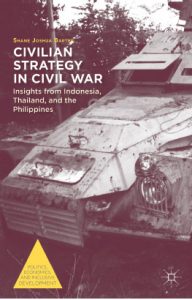
Civilians are typically characterized as the victims of war. While they are indeed victims, focusing solely on their victimization obscures the ways in which civilians navigate bloody conflicts. What options are available to civilians in times of war? Echoing Hirschman, I propose that civilians possess three broad options: flight, support, and voice. This schema provides a memorable, useful approach to understanding how civilians may respond to war. These strategies not only help civilians survive, they can even influence the course of a given conflict. This book is based on multi-site ethnographic research in three Southeast Asian conflicts: Aceh Indonesia, Patani Thailand, and Mindanao Philippines. I conducted open-ended rural interviews with over 300 persons, mostly village chiefs and religious leaders. The civilian perspective sheds new light on cases which have previously been understood in terms of states, rebel movements, and civil society. The flight, support, voice schema allows for new insights into the decisions made by those who choose not to fight. While I by no means disregard security considerations in driving behaviour, socio-cultural factors play surprisingly important roles in shaping civilian strategies.
Reviewed by Damien Kingsbury in Pacific Affairs 89:2 (2016); 485-486
Reviewed by Ariel Ahram in Asian Journal of Social Science 46:1-2 (2018); 205-207
Neither Wolf, Nor Lamb: Embracing Civil Society in the Aceh Conflict (Bangkok: Forum-Asia, 2004).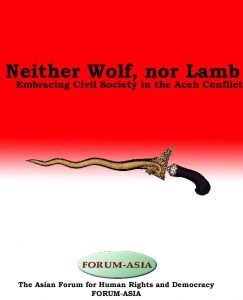
Written for a Southeast Asian NGO in 2004, this book provides a comprehensive assessment of human rights in the Aceh conflict. It suggests that, although the Indonesian military has been responsible for the lion’s share of human rights abuses in the Aceh conflict, human rights groups too often turn a blind eye to human rights abuses committed by the Free Aceh Movement. Written well before the conflict was resolved in 2005, the book serves as an extensive literature review and demands greater neutrality among NGOs.
Journal Articles
“The Partisans: Civilian Support & Indirect Violence,” Journal of Pacifism and Nonviolence 1:2 (2023); 269-290
Although also victims, there is a growing appreciation that civilians are actors in civil wars. Scholarship on civilian agency shows how their decisions impact well-being and even shape conflict dynamics. Civilians are typically framed as impartial forces resisting armed groups and cultivating peace. However, civilians are as likely to support armed groups and deepen violence. This paper seeks to better understand civilian partisanship in civil wars. I argue that forms of civilian support represent indirect violence. Some forms, such as refusing to provide information or protesting enemy human rights abuses, may reduce violence, while providing food or medicine is more neutral. Other actions, such as contributing funds, providing intelligence, recruiting fighters, and procuring weapons, enable armed groups to carry out violence. That civilians contribute indirect violence does not mean they are not victims, but does call their innocence into question, providing a sober account of civilians in war.
“Odd Couple, Strange Marriage: Party Alliance Juxtaposition in Japan,” Asian Survey 62:3 (2022) (co-authored with Shunji Fueki); 385-412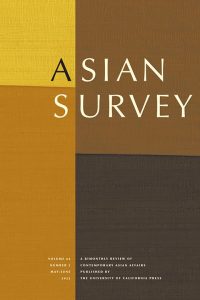
In 2017, Tokyo held landmark prefectural elections featuring a new regional party, Tokyoites First. Fueled by the popularity of governor Yuriko Koike, Tokyoites First gained legislative control through an alliance with Komeito, relegating the Liberal Democratic Party (LDP) to opposition status. The relationship was surprising, especially since Komeito remained a national coalition partner with the LDP. Why would Komeito, a junior partner in a long-standing national alliance with the LDP, simultaneously ally with another party against the LDP subnationally? What explains incongruence, or alliance juxtaposition, where a party has different partners across administrative tiers? We explain this dalliance in terms of institutional factors and party strategy. Tokyo’s distinctive voters and electoral system made for novel coalition opportunities. Strategically, the fling signaled Komeito’s autonomy to its supporters and LDP leaders, showing that its loyalty cannot be assumed.
“Navigating Hard Times: Civilian Strategic Action Amidst Political Violence,” Journal of Oriental Studies (co-authored with Tetsushi Ogata). English version (2023), Japanese version 困難な時代の道筋を探る-政治的暴力のただ中での民間の戦略的行為,” 東洋学術研究 61:1 (2022); 41-68
“Indonesian Autonomies: Contrasting Divergent Self-Government Outcomes in Aceh and Papua,” Publius: The Journal of Federalism 52:1 (2022) (co-authored with Hipolitus Wangge); 55-81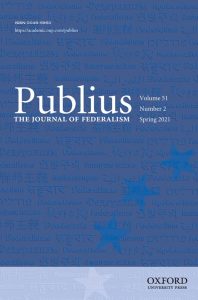
A form of power-sharing, territorial autonomy is essential for managing separatism. Indonesia provides two non-Western cases to illuminate what makes autonomy work. In Aceh, autonomy helped to overcome conflict and can be regarded as successful, while in Papua, autonomy has failed, evident in continued unrest. Within the same country, the same institutional response to violent separatism has generated divergent self-government outcomes. Why has autonomy succeeded in Aceh, but failed in Papua? Utilizing within-case and temporal comparisons, we suggest that the content of autonomy may be less important than the process through which it unfolds. The powers granted to Aceh and Papua are similar, although how self-government was negotiated and whom it empowered varied. Early in Aceh and in Papua, autonomy was essentially imposed, empowering corrupt leaders, and sidelining dissidents. Aceh’s ultimately successful autonomy was negotiated and saw popular former rebels take the reins of self-government.
“Rethinking Territorial Autonomy,” Regional Studies 52:2 (2018); 298-309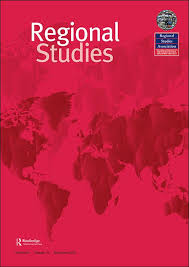
Territorial autonomy represents an important tool to manage tensions involving territorially concentrated ethnic minorities. However, we tend to overlook dynamics within autonomous areas, which tend to centralize power with the local ethnic majority and enable localized nation-building. All autonomous regions feature their own minorities, groups that tend to resist autonomous governments. These phenomena are explored in Aceh, Québec, and Scotland, showing different ways that regional majorities engage with their “second-order” minorities. This paper suggests a need to rethink territorial autonomy, considering territorial or non-territorial autonomy for minorities, minority legal rights, or localized multiculturalism.
“Civilian Strategy across Southeast Asia,” Journal of Peacebuilding and Development 12:3 (2017); 98-103
The countries of Southeast Asia have long been known for their diverse, hospitable, sometimes unruly inhabitants. How have ordinary people in Southeast Asia responded to civil wars? This briefing provides an overview of civilian strategy in three secessionist conflicts: Aceh (Indonesia), Patani (Thailand), and Mindanao (Philippines). It shows that Southeast Asian civilians have resisted armed groups, but have also utilized flight, support, and combined strategies in response to war. This menu of civilian strategy documents diverse forms of civilian action, emphasizing that civilians are hardly inert, passive actors in secessionist conflicts.
“Under a Rebel Flag: Social Resistance under Insurgent Rule in Aceh,” Journal of Resistance Studies 3:1 (2017); 181-209
Resistance is difficult in the best of times and is especially challenging in authoritarian settings. How does social resistance play out in violent armed conflicts, an extreme authoritarian context? Focusing on two key structural factors, this article suggests that while threat is amplified, political opportunity is also considerable, making wartime social resistance high-stakes but not uncommon. This article explores social resistance against popular rebel forces during the recent secessionist conflict in Aceh, Indonesia. It examines four forms of resistance, varying in their visibility and degree of opposition: Engagement, internal, everyday, and defiance. While we must not exaggerate the potential for voice, Aceh’s civilians were able to resist rebel rulers in several ways. This shows that social resistance can blossom even in the most difficult circumstances.
“Dangerous Fieldwork in Southeast Asia,” Comparative Democratization Newsletter 15 (Fall 2017); 21-24
Fieldwork can be exhilarating, especially in conflict areas. It is particularly important for young scholars; although senior professors might have an edge in terms of networks, knowledge, and languages, younger scholars are often willing to go off the beaten path, providing a rare competitive advantage. Although conflict zones are hardly anarchic—there remain social systems and norms that one can navigate—they are clearly unsafe. This brief vignette is not intended to encourage dangerous fieldwork, but for those that have already decided to visit conflict zones in Southeast Asia, I hope it can help ensure a safer, more productive experience.
“Ummah or Tribe? Islamic Practice, Political Ethnocentrism, and Political Attitudes in Indonesia,” Asian Journal of Political Science 25:1 (2017) (co-authored with Nathan W. Allen); 45-67
Existing research has uncovered a link between religion and political ethnocentrism. Religious individuals are relatively inclined to both support policies that benefit their own ethnic group and support political competitors seeking to represent their ethnic group. These findings are broadly consistent with a large body of literature that examines the relationship between religion and ethnic prejudice. To date, empirical research has concentrated overwhelmingly on the linkage between political ethnocentrism and Western Christian beliefs and practices. There is, however, reason to believe that Islamic practice may produce more universalistic beliefs and attitudes. This paper examines the relationship between religious participation and political ethnocentrism in Indonesia, the world’s largest Muslim-majority country. Using survey data collected during the lead up to the 2009 national elections, the paper examines the relationship between religious practice and expressed preference for co-ethnic political leadership. The paper finds that a respondent’s self-reported level of religious activity strongly correlates with stated preference for co-ethnic leadership. Findings from the paper bolster confidence that the relationship between religious participation and ethnocentrism holds outside of the Western Christian context.
“Coffee: An Indian Ocean Perspective,” International Journal of Area Studies 11:2 (2016); 61-81
Studies of coffee are dominated by emphases on Latin American production and American consumption. This paper challenges the Atlantic Ocean perspective, demanding an equal emphasis on the Indian Ocean world of Eastern Africa, the Middle East, South Asia, and Southeast Asia. A geographical approach to historical as well as contemporary patterns of coffee production and consumption provides an opportunity to rethink the nature of coffee as a global commodity. The Indian Ocean world has a much deeper history of coffee, and in recent decades, has witnessed a resurgence in production. The nature of this production is distinct, providing an opportunity to rethink dependency theories. Coffee in the Indian Ocean world is more likely to be produced by smallholders, countries are less likely to be economically dependent, farmers are more likely to harvest polycultures, and countries represent both consumers and producers. A balanced emphasis of Atlantic and Indian Ocean worlds allows us to better understand coffee production and consumption, together telling a more balanced, global story of an important commodity.
“Zones of Control and Civilian Strategy in the Aceh Conflict,” Civil Wars 17:3 (2015)
How do civilians respond to and shape civil war? Dominant approaches emphasize 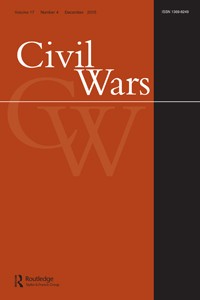 territorial control, while rival sociological explanations understand civilian behaviour as rooted in justice, pleasure, and social norms. This paper assesses these divergent sensibilities by examining rebel-controlled areas from Aceh, Indonesia. Many civilians provided the rebels with symbolic support, information, and provisions, support which deepened over time as the rebels established control. By disaggregating ‘civilians’ into social groups, a more complex story appears. Only some civilian groups supported the dominant armed group, suggesting that control and sociological approaches can be complementary in explaining civilian behaviour.
territorial control, while rival sociological explanations understand civilian behaviour as rooted in justice, pleasure, and social norms. This paper assesses these divergent sensibilities by examining rebel-controlled areas from Aceh, Indonesia. Many civilians provided the rebels with symbolic support, information, and provisions, support which deepened over time as the rebels established control. By disaggregating ‘civilians’ into social groups, a more complex story appears. Only some civilian groups supported the dominant armed group, suggesting that control and sociological approaches can be complementary in explaining civilian behaviour.
“Between a Rock and a Hard Place: Second-Order Minorities in the Aceh Conflict,” Asian Ethnicity 16:2 (2015); 152-165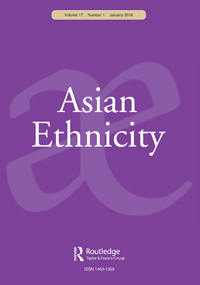
Secessionist movements are often motivated by a sense of exclusion, abuse, and assimilation at the hands of host states. But in waging armed struggles and constructing ethnic nationalisms, they may replicate such grievances against their own minorities. This paper seeks to provide a deeper understanding of how ‘second-order minorities’ respond to secessionist ethno-nationalism. Based on ethnographic research in Aceh, Indonesia, this paper looks to how Javanese, Malay, Alas, and Gayo communities responded to Acehnese secessionism. Aceh’s minorities did not support GAM rebels, opting to flee or resist rebellion. In explaining their reaction, I suggest that the same ethno-nationalist project which united many Acehnese in the secessionist struggle served to repel non-Acehnese communities, leading to ethno-nationalist revivals among Aceh’s minorities and continued tensions in the post-conflict era.
“Second-Order Minorities in Asian Secessionist Conflicts,” Asian Ethnicity 16:2 (2015); 123-135 (Guest Editor)
This article provides some conceptual foundations for a special issue of Asian Ethnicity concerned with what we call ‘second-order minorities’. If secessionist conflicts involve minorities resisting abusive, assimilationist states, leading rebel groups to embark on their own nation-building efforts, how does this affect the minorities of aspiring secessionist nations? How do the minorities of secessionist groups respond to secessionism? Despite many insightful studies of secessionism and rebel ethno-nationalism, scholars have yet to explore the ways that local minorities navigate secessionist conflicts. We suggest that the relationship between secessionists and second-order minorities depends on three key factors: whether minorities are territorially concentrated or dispersed, indigenous or migrant, and nation majorities or small national minorities. These characteristics provide us some idea of the types of violence and counter-mobilization we might see among second-order minorities faced with secessionist violence. This article then previews the subsequent studies of Xinjiang, Aceh, Mindanao, and Sri Lanka, cases which capture some of the core challenges faced by second-order minorities, who face twin violent nation-building efforts from state and rebel forces.
“Strife of the Soil? Unsettling Transmigrant Conflicts in Indonesia,” Journal of Southeast Asian Studies 46:1 (2015) (co-authored with Isabelle Côté); 60-85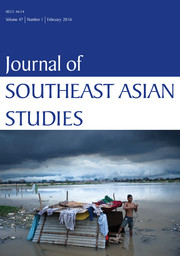
Challenging conventional wisdom, this paper argues that Indonesia—long home to extensive transmigration programmes and a range of conflicts—has not witnessed transmigrant conflicts. The vast majority of Indonesian transmigrants settled in parts of Sumatra which have remained peaceful. In some conflicts, the role of transmigration has been exaggerated. In others, violent conflicts involved spontaneous migrants rather than state-led transmigrants. We conclude with a discussion of two potential outliers, where violence has been directed towards transmigrants, but from disaster-affected regions. This paper demands a more nuanced understanding of how distinct forms of internal migration can lead to violence.
“Area Studies, Asian Studies, and the Pacific Basin,” Geographical Review 105:1 (2015); 105-119
Area Studies tend to approach the world in terms of the peoples, places, and events of specific communities, as opposed to discipline-driven studies which may treat proper nouns solely as variables. This strength withstanding, this paper looks to some criticisms of Area Studies, namely that they may reify ‘areas’ as objective places, overlooking their constructed nature and undermining our ability to grasp cross-regional phenomena. I argue that, for scholars and students, it is useful to play with scale from time to time. I outline three ways that scholars have done so: inter-area studies (border crossings), trans-area studies (creating new areas that straddle traditional ones, see Braudel 1995, Scott 2009), and what I call meta-area studies, in which we locate traditional areas as parts of broader regions. The paper considers one such meta-area, the Pacific Basin, as a way to help situate Southeast Asia and help Southeast Asian Studies respond to a changing world.
“Shrouded: Islam, War, and Holy War in Southeast Asia,” Journal for the Scientific Study of Religion 53:1 (2014) (co-authored with with Ian Zatkin-Osburn); 187-201
The relationship between Islam and armed conflict has been the focus of lively debates, especially in recent years. While many terrorism experts find Holy War wherever they look, others deny the potential of faith to motivate violent resistance. No conflict is entirely motivated by faith, nor is any conflict entirely without it, and the degrees of religious motivation have important consequences for conflict dynamics. How does one gauge the religiosity of a given conflict? We distinguish between two dominant approaches to the study of Holy War—citing scripture and citing militant leaders. While each makes valuable contributions to understanding armed conflict, neither helps us to understand the degree to which a given struggle is understood by Muslim communities to be sacred. Based on rural fieldwork in three Southeast Asian secessionist conflicts, this paper seeks to move forward by providing a series of empirical indicators to help determine the religiosity of a given conflict: the religious credentials of rebel leaders, recruitment networks, public discourse, and burial practices. Burial practices for fallen rebels provide especially novel insights into how conflicts are understood by local religious officials and Muslim communities. Grounded, micro-level empirical indicators offer a window into understanding how armed conflicts are carried out and how they are perceived by civilians.
Rejoinder by Isak Svensson, “Conceptualizing the Religious Dimensions of Armed Conflicts: A Response to ‘Shrouded: Islam, War, and Holy War in Southeast Asia’,” Journal for the Scientific Study of Religion 55:1 (2016); pp. 185-189.
Response by Shane Joshua Barter and Ian Zatkin-Osburn, “Measuring Religion in War: A Response,” Journal for the Scientific Study of Religion 55:1 (2016); pp. 190-193.
“State Proxy or Security Dilemma? Understanding Anti-Rebel Militias in Civil War,” Asian Security 9:2 (2013); 75-92
Militias are responsible for some of the most egregious human rights abuses in civil wars. This said, they vary tremendously, and some may serve as a source of security against abusive rebel groups. What distinguishes predatory anti-rebel militias from those which are more or less popular? While previous studies focus on the relationship between militias and states, this paper demands equal attention to the militia / rebel relationship. While militias in East Timor were largely predatory, formed at the behest of state forces to attack rebel supporters, militias in Aceh were more diverse, and some formed among ethnic minorities against rebel attacks. I propose that militias created where the state dominates are likely to be predatory, while those resisting powerful rebels are more likely to be defensive, popular organizations.
“Unarmed Forces: Civilian Strategy in Violent Conflicts,” Peace & Change 37:4 (2012); 544-571
What options are available to civilians faced with war? While civilians tend to be portrayed as helpless victims—and sometimes are—we know that they are not inert. Borrowing from Albert Hirschman, I propose that civilian strategies can be understood in terms of flight to safer areas, voice to or against armed groups, support for armed groups, and combinations of these three strategies. This paper introduces a simple, intuitive schema for understanding civilian strategy and illustrates it with examples drawn from several armed conflicts. It shows not only do civilians make decisions which enable them to survive bloody conflicts, their strategies may even influence armed groups and the course of a given war.
“Strong State, Smothered Society: Explaining the Forms of Violence in Thailand’s Deep South,” Terrorism and Political Violence 23:2 (2011); 213-232
Why have militants in southern Thailand utilized anonymous and at times indiscriminate terrorist violence against civilians? This paper gauges three explanations: resource wealth, weak states, and strong states. I argue that terrorist violence against civilians in southern Thailand is partially sustained and largely structured by the considerable institutional strength of the Thai state. This helps sustain the conflict by providing an additional grievance and it structures the form of violence by forcing militants underground and severing their links to civilians. A potential response would be to trim state agencies and scale back the presence of the state in Patani.
“The Free Aceh Elections? The 2009 Legislative Contests in Aceh,” Indonesia 91 (2011); 113-130
The 2009 Indonesian Legislative Elections were a significant test for Aceh’s peace and political autonomy, a moment of democratic transition for the troubled province. This article takes a deep look at the 2009 Elections in Aceh, suggesting that while the former rebels scored impressive support, the contests were not simply stories of Partai Aceh (PA) dominance. Firstly, PA success in local elections was confined to districts along the northeast coast. Around Banda, on the west coast, and in the Southeast, PA won bare pluralities, while in the ethnically heterogeneous districts of the interior and southwest, PA fared poorly, losing to national parties. Secondly, the PA victory has overshadowed the equivalent levels of support won by President Yudhoyono’s Partai Demokrat in Aceh’s national ballot. All told, Aceh’s Elections provide a powerful lesson in terms of regional autonomy and post-conflict elections: the former rebels and incumbent national leaders simultaneously won strong mandates, showing that the rewards of peace need not be zero-sum.
“Ulama, the State, and War: Community Islamic Leaders in the Aceh Conflict,” Contemporary Islam 5:1 (2011); 19-36
In recent years, much has been said of the relationship between the headmasters of Islamic boarding schools (ulama), the state, and war. Hoping to clarify how ulama behave in times of war and why they react as they do, I look to the recent secessionist conflict in Aceh, Indonesia. Based on extensive village fieldwork, I find that in response to the conflict, Aceh’s ulama were divided; some supported the rebels, some supported the state, and some remained neutral. These positions were largely predicted by combatant control, a pragmatic response to conflict dynamics. Sub-regional comparisons, temporal comparisons, and interviews suggest that while many ulama sided with power, they also sided against human rights abuses, a concern for social justice which may be rooted in religious sentiment after all.
“Resources, Religion, & Rebellion: The Sources of Conflict in Aceh,” Small Wars & Insurgencies 19:1 (2008); 39-61
A clear understanding of what creates a conflict is central to building a lasting peace. This paper targets two common misconceptions which cloud analyses of the recent separatist conflict in Aceh. First, the conflict was not about oil. Resource curse theories help explain the creation of the Free Aceh Movement (GAM), but cannot explain why the conflict remained limited for several years. The lessons here are that what motivates a conflict varies over time and across groups. Second, despite Acehnese history, identity, and global trends, the conflict was not marked by Islam. Instead, the GAM promoted ethnic nationalism and downplayed religion to sustain the conflict and their control of it. The lesson here is how leaders can shape, but cannot determine the identity of movements. Beyond these two misconceptions, I move towards explaining the causal mechanisms of the Aceh conflict and assessing this model in light of post-Tsunami developments.
Book Chapters
“Overcoming Civil Wars in the Asia-Pacific,” in The Politics of the Asia-Pacific: Triumphs, Challenges, and Threats, ed. Mark Williams (University of Toronto Press 2022); 212-225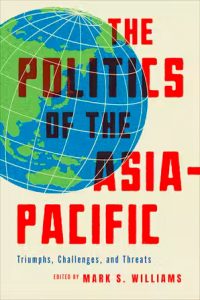
When Ferdinand Magellan rounded South America in 1519 en route to Asia, he found the waters calm and easy to sail. He dubbed these waters pacifico—peaceful—a name that would come to stick. Despite this inspired name, the Asia-Pacific region has hardly been peaceful. On one hand, the past 50–75 years have seen a marked decline in wars between countries. On the other hand, Asia-Pacific countries have suffered numerous wars within their borders. This chapter seeks to make sense of the broad range of Asia-Pacific civil wars. It refers to three major forms of civil war: revolutionary, separatist, and communal conflicts. The first are wars about ideas, aimed at capturing power at the center, while the latter are ethnic conflicts with more localized interests. This chapter provides examples of each form of conflict and concludes with ways to encourage a more pacific Asia.
“Disturbing the Peace: Paramilitarism across Southeast Asia,” in Paramilitary Groups and the State under Globalization: Political Violence, Elites, and Security, eds. Jasmin Hristov, Jeb Sprague, and Aaron Tauss (Routledge 2022); 235-254
Reviewed by Samuel Cohn, at https://www.samuelcohn.net/rethinking-death-squads. 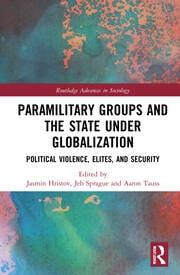
The study of civil war has evolved considerably, including attention to paramilitaries, militias, and related armed groups. From case-driven qualitative research to quantitative data sets, there is new interest in the formation, behaviour, and effects of paramilitaries. However, how we conceptualize such groups remains muddled. Scholars remain wedded to national dynamics, seeing paramilitaries as pro-government while overlooking localized power. The goals of paramilitaries are often assumed instead of examined. This chapter seeks to challenge dominant views of paramilitaries by providing an inventory of sorts across Southeast Asia. In a region known for its diversity, paramilitary forces are immensely varied. Many are pro-government or pro-state, while others are neutral, opposed, or simply ambiguous. In many cases, paramilitaries are loyal to local power brokers, businessmen with access to capital or regional minority groups. Paramilitaries across Southeast Asia possess complex loyalties and fluid identities, challenging dominant views that they are pro-government.
“Ethnic Conflict in Southeast Asia” in Routledge Handbook of Race and Ethnicity in Asia, edited by Michael Weiner (London: Routledge 2021); 137-150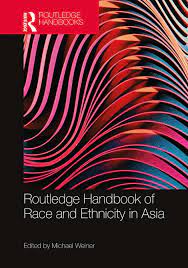
Home to a variety of world religions, writing systems, languages, and cultural traditions, Southeast Asia is a region known for its immense ethnic diversity. While this diversity is generally a blessing, allowing for cultural enrichment and fusion, it has sometimes stood as a curse, with Southeast Asia beset by various ethnic conflicts. This chapter examines some of the concepts, cases, and solutions related to ethnic conflicts in Southeast Asia. It outlines distinct forms of ethnic conflict, namely secessionist and communal conflicts, arguing that different forms of ethnic conflict demand distinctive approaches to peace.
“Travel Learning Clusters as Signature Pedagogies” in Signature Pedagogies in International Relations, edited by Jan Lüdert (Bristol: E-International Relations 2021); 84-96.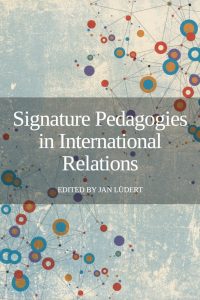
This chapter analyzes travel “Learning Cluster” (LC) courses as signature pedagogies. Taught at a small liberal arts university in southern California, LCs are intense winter block courses that typically focus on unique topics, with some involving travel. After locating LCs in various pedagogical concepts and explaining how these courses work, this chapter analyzes some challenges and successes in teaching travel LCs. Challenges include selecting students, addressing racial and gender identities, health and safety, etiquette, assessing firsthand experiences, and returning to campus. These challenges are offset by some incredible benefits of field-based education, including achieving primary and secondary learning objectives through experiential education, meeting people with diverse perspectives, making enduring local connections, elevating less privileged students, and future learning opportunities. All told, field-based LCs have represented some of the most exhausting, rewarding moments of my teaching career, representing a signature pedagogy in international studies.
“State Violence and Religion,” in Religious Violence Today: Faith and Conflict in the Modern World, edited by Michael Jerryson (ABC-CLIO, 2020); 705-782. With SUA students Amanda Boralessa; Mahesh Kushwaha; Vassil Yorgov; Jaroslav Zapletal.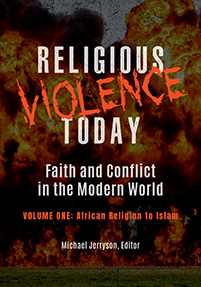
The separation between church and state—between cosmological and political orders—represents a cornerstone of modern politics. But it has always been an uneasy, incomplete separation. Historically, political authority was entwined with the state, and, even today, religion pervades supposedly secular politics. Religion can provide the state with legitimacy and resources, while political authorities can elevate a chosen faith while suppressing others. One of the key functions of the state is to monopolize violence, raising armies to help enforce its policies. As a result, the blending of spiritual and political authority is, too often, intimately linked to violence—understood here in terms of the physical use of force that is intended to inflict suffering on others.
“Southeast Asia: Unity in ASEAN,” in Routledge Handbook of Politics in Asia, edited by Shiping Hua (Routledge, 2018); 98-109 (co-authored with Amanda Boralessa)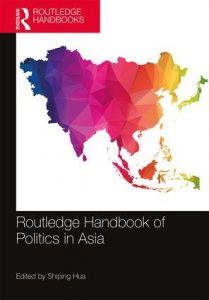
Despite being home to tremendous diversity, Southeast Asia stands out for its exceptional cohesion in foreign affairs. All countries in the region are members of the Association of Southeast Asian Nations (ASEAN), and they increasingly speak with one voice in international relations. This chapter provides an overview of foreign affairs in Southeast Asia through ASEAN while also noting ways in which countries continue to conduct foreign relations independent of the regional body. The first section sketches out a brief history of Southeast Asian foreign relations. The second section focuses on ASEAN, noting the tumultuous intra-regional relations that preceded it and how the Association has contributed to regional stability. After discussing some of the major debates surrounding ASEAN, the chapter explains how, through ASEAN, Southeast Asia is increasingly united in global affairs. This said, there remain divisions among ASEAN countries, and many states maintain distinctive foreign relations beyond the confines of ASEAN, gaps especially evident in disputes over the South China Sea. The chapter concludes by considering some future directions for foreign relations in Southeast Asia.
“The Rebel State in Society: Accommodation & Governance in the Aceh Conflict,” in Rebel Governance in Civil War, edited by Ana Arjona, Nelson Kasfir, and Zachariah Mampilly (Cambridge University Press, 2015); 226-245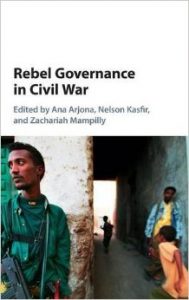
Rebel organizations cannot be understood solely in terms of their coercive capacities. Many seek to displace the state and usurp its functions. How do rebel groups establish systems of governance? Applying Migdal’s state in society approach, I show how rebel governance can evolve through alliances with societal forces. I do so by focusing on the evolution of the Free Aceh Movement (GAM) in Indonesia. GAM came to govern a handful of districts by allying with two groups, rural Islamic teachers (ulama) and urban student activists, whose goals and identities were in many ways at odds with its own. These rebel state / society alliances were mutually beneficial. Ulama and activists gained security and were able to pursue their agendas through GAM, which in turn gained wider support and the capacity to govern the local population. These alliances were also transformative, resulting in significant convergence in terms of the identities and goals of all parties.
“Learning to Lose? Not if UMNO Can Help It,” in Political Transitions in Dominant Party Systems, edited by Joseph Wong & Edward Friedman (Routledge, 2008) ; 211-230 (co-authored with Diane Mauzy)
; 211-230 (co-authored with Diane Mauzy)
Elections, ideally free, fair, and competitive, are an important component of democracy. Recently, a number of dominant parties which had seemed so indomitable not long ago have since peacefully surrendered power and turned their attentions to competing against other parties in order to regain electoral power. The central question of this collection, why some governing parties “learn to lose” by accepting democratic alternations of power and others do not, is an enticing and important one. In Malaysia, the United Malays National Organization (UMNO) has never had its dominance seriously challenged and so has never had to “learn to lose”; indeed it remains unassailable. This paper focuses on four interrelated questions. First, how did UMNO emerge as a dominant party? Second, how has UMNO successfully defied the trend that has seen the decline of many dominant parties? Third, how has UMNO reacted to major crises, allowing it to preserve its dominance? And fourth, are there any grounds to suggest that UMNO’s dominance might be challenged in the near future? Although UMNO’s dominance seems secure today, it is possible that one day this outlier, facing a major electoral or intra-party crisis, will have to decide whether to become more authoritarian to retain power or more democratic by surrendering it.
Book Reviews
“Democracy and Nationalism in Southeast Asia, by Jacques Bertrand,” Pacific Affairs 95:2 (2022)
“Rethinking Locality in Japan, edited by Sonja Ganesforth and Hanno Jentzsch,” IIAS Newsletter 92 / Newbooks.asia (2022) (with Kenichi Ebisutani, SUA student)
“The Liberal Democratic Party of Japan: The Realities of Power, by Kōji Nakakita,” IIAS Newsletter 88 / New Books.asia (2021) (with Shunji Fueki, SUA student)
“Elusive Belonging: Marriage Immigrants and Multiculturalism in Rural South Korea, by Minjeong Kim,” Asian Journal of Social Science 48:5-6 (2020) (with Nini Vo, SUA student)
“Democracy for Sale: Elections, Clientelism, and the State in Indonesia, by Ed Aspinall and Ward Berenschot,” Pacific Affairs (2020)
“Islam State and Society in Indonesia: Local Politics in Madura, by Pribadi Yanwar,” Asian Journal of Social Science 48:1 (2020) (with Nikita Sukmono, SUA student)
“From Secret Ballot to Democracy Sausage: How Australia Got Compulsory Voting, by Judith Brett,” Pacific Affairs 93:1 (2020) (with Ana Schugurensky, SUA student)
“Familial Properties, by Nhung Tuyet Tran,” IIAS Newsletter (2019) (with Ha Chau Ngo, SUA student
“China’s Political System, by Sebastian Heilmann,” IIAS Newsletter (2018) (with Jaroslav Zapletal)
“Building Filipino Hawai‘i, by Roderick Labrador,” IIAS Newsletter (2017) (with Rayen Rooney)
“The Making of Middle Indonesia: Middle Classes in Kupang Town, 1930s-1980s, by Gerry van Klinken,” Pacific Affairs 90:2 (2017)
“Religious Diversity in Muslim-Majority States in Southeast Asia by Bernhard Platzdasch and Johan Saravanamuttu,” Asian Journal of Social Science (2016) (with Gabrielle Garfunkel)
“The Roots of Terrorism in Indonesia, by Solahudin,” Pacific Affairs 88:4 (2015)
“Political Change & Territoriality in Indonesia by Ehito Kimura,” Canadian Journal of Political Science 88:4 (2015)
“Soldiers and Diplomacy in Burma: Understanding the Foreign Relations of the Burmese Praetorian State by Renaud Egreteau and Larry Jagan,” IIAS Newsletter 72 (2015) (with Yuko Nakajima)
“Ghosts of the Past in Southern Thailand, edited by Patrick Jory,” IIAS Newsletter 69 (2014)
“Violence and Vengeance: Religious Conflict and its Aftermath in Eastern Indonesia by Christopher R. Duncan,” Sojourn 29:2 (2014)
“From Colonization to Nation-State: The Political Demography of Indonesia by Riwanto Tirtosudarmo” IIAS Newsletter 67 (2014)
“Regime Change and Ethnic Politics in Indonesia: Dayak Politics of West Kalimantan by Taufiq Tanasaldy,” South East Asia Research 22:3 (2014)
“Ordering Power: Contentious Politics and Authoritarian Leviathans in Southeast Asia by Dan Slater,” The Southeast Review of Asian Studies 35 (2013)
“The Art of Not Being Governed: An Anarchist History of Upland Southeast Asia by James C. Scott,” Canadian Journal of Political Science 44:04 (2011)
“Islam and Nation: Separatist Rebellion in Aceh, Indonesia by Edward Aspinall,” Pacific Affairs 83:2 (2010)
“From Rebellion to Riots: Collective Violence on Indonesian Borneo by Jamie S. Davidson,” South East Asia Research 18:1 (2010)
“Zones of Peace edited by Landon E. Hancock and Christopher Mitchell,” Peace Review 21:4 (2010)
“Realpolitik Ideology: Indonesia’s Use of Military Force by Leonard C. Sebastian,” Pacific Affairs 81:1 (2008)
“Verandah of Violence: Background to the Aceh Problem edited by Anthony Reid,” Pacific Affairs 80:3 (2007)
Other
“Aceh in the 2024 Indonesian Elections: Self-Rule with Shared Spoils,” Melbourne Indonesia Blog (2024)
“Civilian Support as Indirect Violence,” Pacifism and Nonviolence Research Network Blog (2023)
“For A Wider Understanding of Territorial Autonomies,” IACL Blog (2023)
“A Fruitful Union of Fact & Theory: Diane Mauzy on Political Science in Southeast Asia,” CCSEAS Newsletter 15:1 (2022)
Feature on co-authored book reviews and student mentorship, IIAS Newsletter 88 (2021)
“Defending the Minorities of Minorities,” The Pearl (Fall 2017)
“Intimate Economies: Sex Tourism in Southeast Asia,” Verge Magazine 4:2 (Spring 2014)
“Strange Bedfellows: The Limits of Partai Aceh Loyalty,” Inside Indonesia 113 (September 2013)
“Minor Threat? Cracking Down on Punks in Aceh, Indonesia,” CAPI Newsletter (Spring 2013)
Featured in “How Holy is This Holy War,” by Kaela O’Brien, Portland State Vanguard (January 2013)
“Islam in Politics, not Political Islam in Indonesian Elections,” Sociology of Islam Newsletter 6 (2011)
“Boxing Day in Cotabato, Mindanao,” Explorations Southeast Asia 9 (2009); pp. 113-114
“A Deeper Look into the Recent Elections in Aceh,” Jakarta Post (28 April 2009)
“Language and the Southern Thai Conflict,” Malaysiakini (17 October 2008)
“Random Acts of Curiosity,” Verge Magazine (2008)
“Notes from Indonesia,” CCHS Human Security Bulletin 9:4 (March 2008)
Featured in “From the Ground Up,” by Tom Peacock, Verge Magazine 4:2 (Spring 2006)
Featured in “Tsunami Response: One Year Later,” by Brian Lin, UBC Reports 52:1 (January 2006)
“Reconstruction and Conflict Resolution in Aceh,” CANCAPS Bulletin (20 August 2005)
“Peace Talks in Post-Tsunami Aceh,” Human Security Bulletin (August 2005)
“Swedish Court’s Acquittal of Hassan and Accountability for Abuses in Aceh,” Jakarta Post (17 July 2004)
